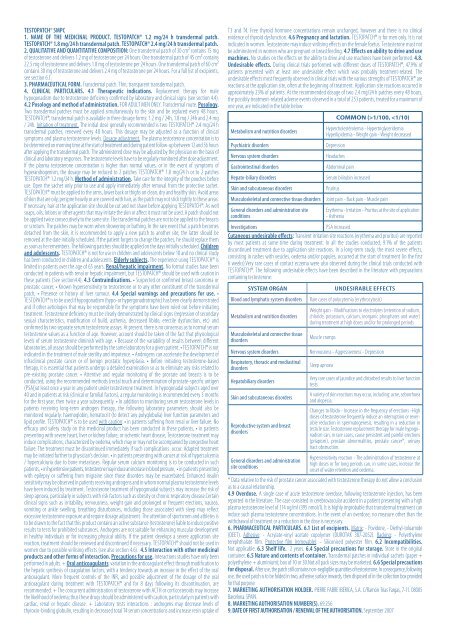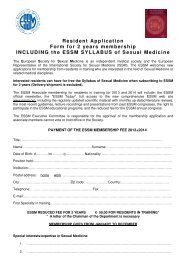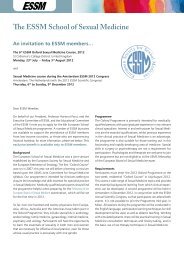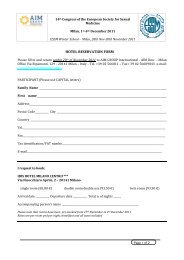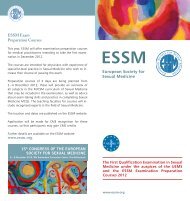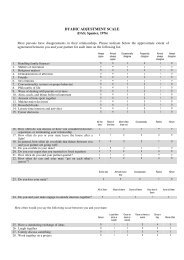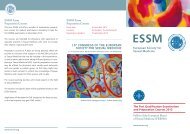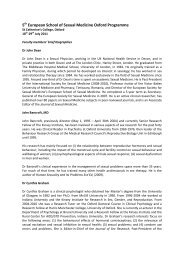final PrograM 13th Congress of the european society for ... - ESSM
final PrograM 13th Congress of the european society for ... - ESSM
final PrograM 13th Congress of the european society for ... - ESSM
You also want an ePaper? Increase the reach of your titles
YUMPU automatically turns print PDFs into web optimized ePapers that Google loves.
TESTOPATCH® SMPC<br />
1. NAME OF THE MEDICINAL PRODUCT. TESTOPATCH® 1.2 mg/24 h transdermal patch.<br />
TESTOPATCH® 1.8 mg/24 h transdermal patch. TESTOPATCH® 2.4 mg/24 h transdermal patch.<br />
2. QUALITATIVE AND QUANTITATIVE COMPOSITION: One transdermal patch <strong>of</strong> 30 cm² contains 15 mg<br />
<strong>of</strong> testosterone and delivers 1.2 mg <strong>of</strong> testosterone per 24 hours. One transdermal patch <strong>of</strong> 45 cm² contains<br />
22.5 mg <strong>of</strong> testosterone and delivers 1.8 mg <strong>of</strong> testosterone per 24 hours. One transdermal patch <strong>of</strong> 60 cm²<br />
contains 30 mg <strong>of</strong> testosterone and delivers 2.4 mg <strong>of</strong> testosterone per 24 hours. For a full list <strong>of</strong> excipients,<br />
see section 6.1.<br />
3. PHARMACEUTICAL FORM. Transdermal patch. Thin, transparent transdermal patch.<br />
4. CLINICAL PARTICULARS. 4.1 Therapeutic indications. Replacement <strong>the</strong>rapy <strong>for</strong> male<br />
hypogonadism due to testosterone deficiency confirmed by laboratory and clinical signs (see section 4.4).<br />
4.2 Posology and method <strong>of</strong> administration. FOR ADULT MEN ONLY. Transdermal route. Posology.<br />
Two transdermal patches must be applied simultaneously to <strong>the</strong> skin and be replaced every 48 hours.<br />
TESTOPATCH®, transdermal patch is available in three dosage <strong>for</strong>ms: 1.2 mg / 24h, 1.8 mg / 24h and 2.4 mg<br />
/ 24h. Initiation <strong>of</strong> treatment. The initial dose generally recommended is two TESTOPATCH® 2.4 mg/24 h<br />
transdermal patches, renewed every 48 hours. This dosage may be adjusted as a function <strong>of</strong> clinical<br />
symptoms and plasma testosterone levels. Dosage adjustment. The plasma testosterone concentration is to<br />
be determined on morning time at <strong>the</strong> start <strong>of</strong> treatment and during patient follow-up between 12 and 36 hours<br />
after applying <strong>the</strong> transdermal patch. The administered dose may be adjusted by <strong>the</strong> physician on <strong>the</strong> basis <strong>of</strong><br />
clinical and laboratory responses. The testosterone levels have to be regularly monitored after dose adjustment.<br />
If <strong>the</strong> plasma testosterone concentration is higher than normal values, or in <strong>the</strong> event <strong>of</strong> symptoms <strong>of</strong><br />
hyperandrogenism, <strong>the</strong> dosage may be reduced to 2 patches TESTOPATCH® 1.8 mg/24 h or to 2 patches<br />
TESTOPATCH® 1.2 mg/24 h. Method <strong>of</strong> administration. Take care <strong>for</strong> <strong>the</strong> integrity <strong>of</strong> <strong>the</strong> pouches be<strong>for</strong>e<br />
use. Open <strong>the</strong> sachet only prior to use and apply immediately after removal from <strong>the</strong> protective sachet.<br />
TESTOPATCH® must be applied to <strong>the</strong> arms, lower back or thighs on clean, dry and healthy skin. Avoid areas<br />
<strong>of</strong> skin that are oily, perspire heavily or are covered with hair, as <strong>the</strong> patch may not stick tightly to <strong>the</strong>se areas.<br />
If necessary, hair at <strong>the</strong> application site should be cut and not shave be<strong>for</strong>e applying TESTOPATCH®. As well<br />
soaps, oils, lotions or o<strong>the</strong>r agents that may irritate <strong>the</strong> skin or affect it must not be used. A patch should not<br />
be applied twice consecutively to <strong>the</strong> same site. The transdermal patches are not to be applied to <strong>the</strong> breasts<br />
or scrotum. The patches may be worn when showering or bathing. In <strong>the</strong> rare event that a patch becomes<br />
detached from <strong>the</strong> skin, it is recommended to apply a new patch to ano<strong>the</strong>r site; <strong>the</strong> latter should be<br />
removed at <strong>the</strong> date initially scheduled. If <strong>the</strong> patient <strong>for</strong>gets to change <strong>the</strong> patches, he should replace <strong>the</strong>m<br />
as soon as he remembers. The following patches should be applied on <strong>the</strong> days initially scheduled. Children<br />
and adolescents. TESTOPATCH® is not <strong>for</strong> use in children and adolescents below 18 and no clinical study<br />
has been conducted in children and adolescents. Elderly subjects. The experience using TESTOPATCH® is<br />
limited in patients over <strong>the</strong> age <strong>of</strong> 65 years. Renal/hepatic impairment. No <strong>for</strong>mal studies have been<br />
conducted in patients with renal or hepatic impairment, but TESTOPATCH® should be used with caution in<br />
<strong>the</strong>se patients (See section4.4). 4.3 Contraindications. • Suspected or confirmed breast carcinoma or<br />
prostatic cancer, • Known hypersensitivity to testosterone or to any o<strong>the</strong>r constituent <strong>of</strong> <strong>the</strong> transdermal<br />
patch, • Presence or history <strong>of</strong> liver tumour. 4.4 Special warnings and precautions <strong>for</strong> use. •<br />
TESTOPATCH® is to be used if hypogonadism (hypo-or hypergonadrotrophic) has been clearly demonstrated<br />
and if o<strong>the</strong>r aetiologies that may be responsible <strong>for</strong> <strong>the</strong> symptoms have been ruled out be<strong>for</strong>e initiating<br />
treatment. Testosterone deficiency must be clearly demonstrated by clinical signs (regression <strong>of</strong> secondary<br />
sexual characteristics, modification <strong>of</strong> build, as<strong>the</strong>nia, decreased libido, erectile dysfunction, etc) and<br />
confirmed by two separate serum testosterone assays. At present, <strong>the</strong>re is no consensus as to normal serum<br />
testosterone values as a function <strong>of</strong> age. However, account should be taken <strong>of</strong> <strong>the</strong> fact that physiological<br />
levels <strong>of</strong> serum testosterone diminish with age. • Because <strong>of</strong> <strong>the</strong> variability <strong>of</strong> results between different<br />
laboratories, all assays should be per<strong>for</strong>med by <strong>the</strong> same laboratory <strong>for</strong> a given patient. • TESTOPATCH® is not<br />
indicated in <strong>the</strong> treatment <strong>of</strong> male sterility and impotence. • Androgens can accelerate <strong>the</strong> development <strong>of</strong><br />
infraclinical prostate cancer or <strong>of</strong> benign prostatic hyperplasia. • Be<strong>for</strong>e initiating testosterone-based<br />
<strong>the</strong>rapy, it is essential that patients undergo a detailed examination so as to eliminate any risks related to<br />
pre-existing prostate cancer. • Attentive and regular monitoring <strong>of</strong> <strong>the</strong> prostate and breasts is to be<br />
conducted, using <strong>the</strong> recommended methods (rectal touch and determination <strong>of</strong> prostate-specific antigen<br />
(PSA))at least once a year in any patient under testosterone treatment. In hypogonadal subjects aged over<br />
40 and in patients at risk (clinical or familial factors), a regular monitoring is recommended every 3 months<br />
<strong>for</strong> <strong>the</strong> first year, <strong>the</strong>n twice a year subsequently. • In addition to monitoring serum testosterone levels in<br />
patients receiving long-term androgen <strong>the</strong>rapy, <strong>the</strong> following laboratory parameters should also be<br />
monitored regularly: haemoglobin, hematocrit (to detect any polyglobulia) liver function parameters and<br />
lipid pr<strong>of</strong>ile. TESTOPATCH® is to be used with caution: • in patients suffering from renal or liver failure. No<br />
efficacy and safety study on this medicinal product has been conducted in <strong>the</strong>se patients, • in patients<br />
presenting with severe heart, liver or kidney failure, or ischemic heart disease, Testosterone treatment may<br />
induce complications, characterized by oedema, which may or may not be accompanied by congestive heart<br />
failure. The treatment must be discontinued immediately if such complications occur. Adapted treatment<br />
may be initiated fur<strong>the</strong>r to physician’s decision. • in patients presenting with cancer at risk <strong>of</strong> hypercalcemia<br />
/ hypercalciuria due to bone metastases. Regular serum calcium monitoring is to be conducted in such<br />
patients, • in hypertensive patients, testosterone may induce an increase in blood pressure, • in patients presenting<br />
with epilepsy or suffering from migraine since those disorders may be exacerbated. Enhanced insulin<br />
sensitivity may be observed in patients receiving androgens and in whom normal plasma testosterone levels<br />
have been induced by treatment. Testosterone treatment <strong>of</strong> hypogonadal subjects may increase <strong>the</strong> risk <strong>of</strong><br />
sleep apnoea, particularly in subjects with risk factors such as obesity or chronic respiratory disease.Certain<br />
clinical signs such as irritability, nervousness, weight gain and prolonged or frequent erections, nausea,<br />
vomiting or ankle swelling, breathing disturbances, including those associated with sleep may reflect<br />
excessive testosterone exposure and require dosage adjustment. The attention <strong>of</strong> sportsmen and athletes is<br />
to be drawn to <strong>the</strong> fact that this product contains an active substance (testosterone) liable to induce positive<br />
results to tests <strong>for</strong> prohibited substances. Androgens are not suitable <strong>for</strong> enhancing muscular development<br />
in healthy individuals or <strong>for</strong> increasing physical ability. If <strong>the</strong> patient develops a severe application site<br />
reaction, treatment should be reviewed and discontinued if necessary. TESTOPATCH® should not be used in<br />
women due to possible virilising effects (see also section 4.6). 4.5 Interaction with o<strong>the</strong>r medicinal<br />
products and o<strong>the</strong>r <strong>for</strong>ms <strong>of</strong> interaction. Precautions <strong>for</strong> use. Interactions studies have only been<br />
per<strong>for</strong>med in adults. + Oral anticoagulants: variation in <strong>the</strong> anticoagulant effect through modification to<br />
<strong>the</strong> hepatic syn<strong>the</strong>sis <strong>of</strong> coagulation factors, with a tendency towards an increase in <strong>the</strong> effect <strong>of</strong> <strong>the</strong> oral<br />
anticoagulant. More frequent controls <strong>of</strong> <strong>the</strong> INR, and possible adjustment <strong>of</strong> <strong>the</strong> dosage <strong>of</strong> <strong>the</strong> oral<br />
anticoagulant during treatment with TESTOPATCH® and <strong>for</strong> 8 days following its discontinuation, are<br />
recommended. + The concurrent administration <strong>of</strong> testosterone with ACTH or corticosteroids may increase<br />
<strong>the</strong> likelihood <strong>of</strong> oedema; thus <strong>the</strong>se drugs should be administered with caution, particularly in patients with<br />
cardiac, renal or hepatic disease. + Laboratory tests interactions : androgens may decrease levels <strong>of</strong><br />
thyroxin-binding globulin, resulting in decreased total T4 serum concentrations and increase resin uptake <strong>of</strong><br />
T3 and T4. Free thyroid hormone concentrations remain unchanged, however and <strong>the</strong>re is no clinical<br />
evidence <strong>of</strong> thyroid dysfunction. 4.6 Pregnancy and lactation. TESTOPATCH® is <strong>for</strong> men only. It is not<br />
indicated in women. Testosterone may induce virilising effects on <strong>the</strong> female foetus. Testosterone must not<br />
be administered in women who are pregnant or breastfeeding. 4.7 Effects on ability to drive and use<br />
machines. No studies on <strong>the</strong> effects on <strong>the</strong> ability to drive and use machines have been per<strong>for</strong>med. 4.8.<br />
Undesirable effects. During clinical trials per<strong>for</strong>med with different doses <strong>of</strong> TESTOPATCH®, 47.9% <strong>of</strong><br />
patients presented with at least one undesirable effect which was probably treatment-related. The<br />
undesirable effects most frequently observed in clinical trials with <strong>the</strong> various strengths <strong>of</strong> TESTOPATCH® are<br />
reactions at <strong>the</strong> application site, <strong>of</strong>ten at <strong>the</strong> beginning <strong>of</strong> treatment. Application site reactions occurred in<br />
approximately 23% <strong>of</strong> patients. At <strong>the</strong> recommended dosage <strong>of</strong> two 2.4 mg/24 h patches every 48 hours,<br />
<strong>the</strong> possibly treatment-related adverse events observed in a total <strong>of</strong> 253 patients, treated <strong>for</strong> a maximum <strong>of</strong><br />
one year, are indicated in <strong>the</strong> table below:<br />
Metabolism and nutrition disorders<br />
Psychiatric disorders<br />
Nervous system disorders<br />
Gastrointestinal disorders<br />
Hepato-biliary disorders<br />
Skin and subcutaneous disorders<br />
Musculoskeletal and connective tissue disorders<br />
General disorders and administration site<br />
conditions<br />
COMMON (>1/100,


